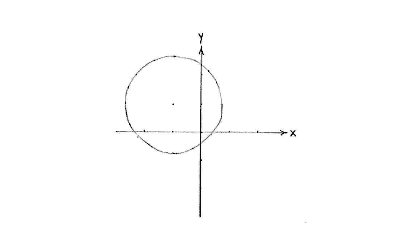Solution 4.1:7a
From Förberedande kurs i matematik 1
(Difference between revisions)
m |
|||
| Line 1: | Line 1: | ||
| - | As the equation stands, it is difficult directly to know anything about the circle, but if we complete the square and combine | + | As the equation stands, it is difficult directly to know anything about the circle, but if we complete the square and combine ''x''- and ''y''-terms together in their own respective square terms, then we will have the equation in the standard form |
| - | + | ||
| - | - and | + | |
| - | + | ||
| - | - terms together in their own respective square terms, then we will have the equation in the standard form | + | |
| - | + | ||
| - | + | ||
| - | + | ||
| + | {{Displayed math||<math>(x-a)^2 + (y-b)^2 = r^2\,,</math>}} | ||
and we will then be able to read off the circle's centre and radius. | and we will then be able to read off the circle's centre and radius. | ||
| - | If we take the | + | If we take the ''x''- and ''y''-terms on the left-hand side and complete the square, we get |
| - | + | ||
| - | - and | + | |
| - | + | ||
| - | - terms on the left-hand side and complete the square, we get | + | |
| - | + | {{Displayed math||<math>\begin{align} | |
| - | <math>x^ | + | x^2 + 2x &= (x+1)^2-1^2\,,\\[5pt] |
| - | + | y^2 - 2y &= (y-1)^2-1^2\,, | |
| - | + | \end{align}</math>}} | |
| - | + | ||
and then the whole equation can be written as | and then the whole equation can be written as | ||
| - | + | {{Displayed math||<math>(x+1)^2 - 1^2 + (y-1)^2 - 1^2 = 1\,,</math>}} | |
| - | <math> | + | |
| - | + | ||
or, with the constants moved to the right-hand side, | or, with the constants moved to the right-hand side, | ||
| + | {{Displayed math||<math>(x+1)^2 + (y-1)^2 = 3\,\textrm{.}</math>}} | ||
| - | <math>\ | + | This is a circle having its centre at (-1,1) and radius <math>\sqrt{3}\,</math>. |
| - | + | ||
| - | This is a circle having its centre at | ||
| - | <math>\left( -1 \right.,\left. 1 \right)</math> | ||
| - | and radius | ||
| - | <math>\sqrt{3}</math>. | ||
| - | {{NAVCONTENT_START}} | ||
<center> [[Image:4_1_7a-2(2).gif]] </center> | <center> [[Image:4_1_7a-2(2).gif]] </center> | ||
| - | {{NAVCONTENT_STOP}} | ||
Current revision
As the equation stands, it is difficult directly to know anything about the circle, but if we complete the square and combine x- and y-terms together in their own respective square terms, then we will have the equation in the standard form
| \displaystyle (x-a)^2 + (y-b)^2 = r^2\,, |
and we will then be able to read off the circle's centre and radius.
If we take the x- and y-terms on the left-hand side and complete the square, we get
| \displaystyle \begin{align}
x^2 + 2x &= (x+1)^2-1^2\,,\\[5pt] y^2 - 2y &= (y-1)^2-1^2\,, \end{align} |
and then the whole equation can be written as
| \displaystyle (x+1)^2 - 1^2 + (y-1)^2 - 1^2 = 1\,, |
or, with the constants moved to the right-hand side,
| \displaystyle (x+1)^2 + (y-1)^2 = 3\,\textrm{.} |
This is a circle having its centre at (-1,1) and radius \displaystyle \sqrt{3}\,.

